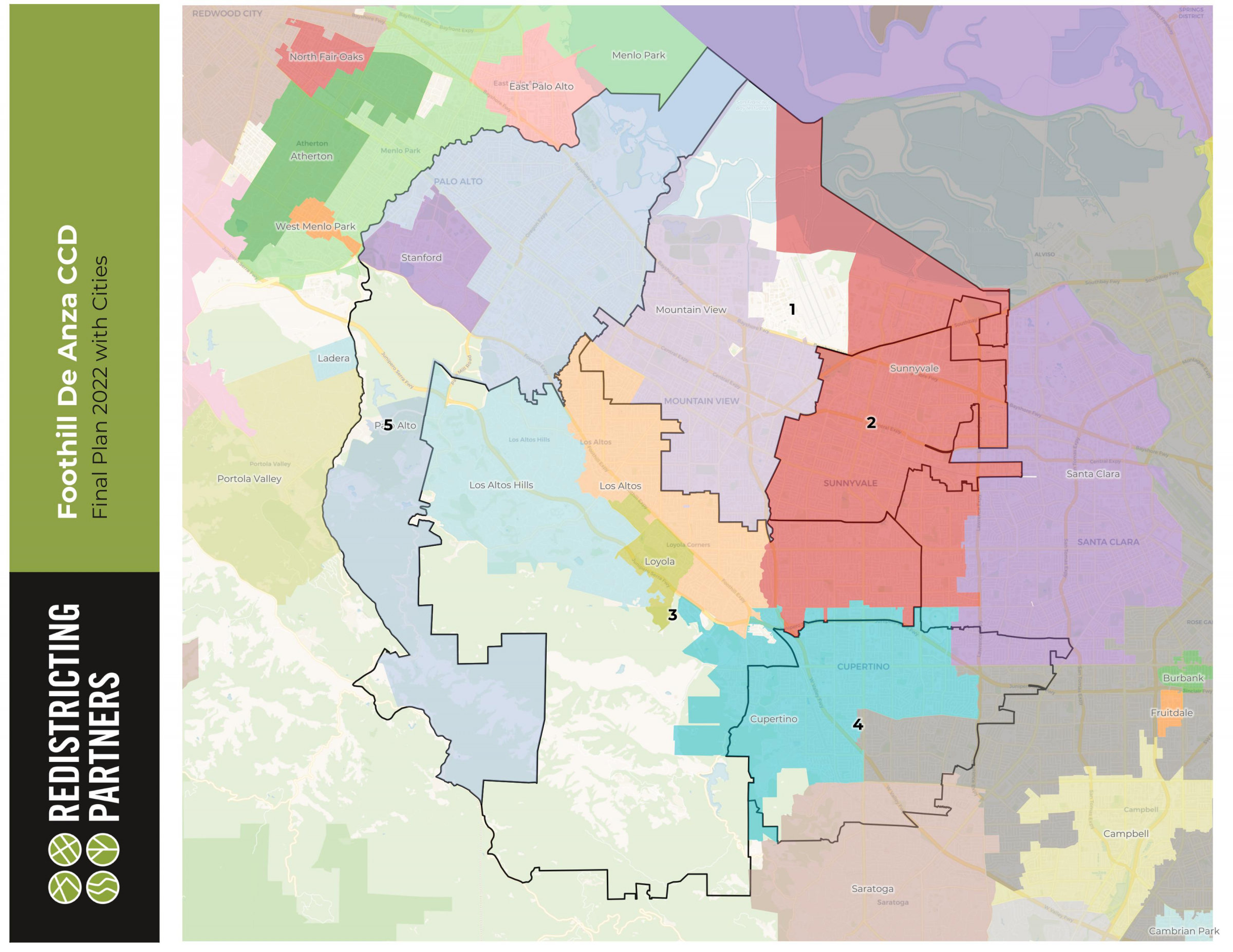The monthslong process to overhaul the way elections operate in the Foothill-De Anza Community College District is now complete, with the board approving this week a map that splits the district into five regions so that voters in each area can elect a single trustee who lives in that portion of the district.
For the first time since its founding in 1957, the district is moving away from at-large elections, in which voters across the district pick all five trustees, to an area-based system.
The trustees voted 4-1 at a Monday, Feb. 14, meeting to approve a map that draws trustee areas based on underlying city boundaries and voted by the same margin to create the order in which each region will come up for a vote. Gilbert Wong cast the lone dissenting vote on both motions.
This November, elections will be held for trustee areas two and four, which are in the eastern section of the district and encompass large parts of Sunnyvale and Cupertino, as well as smaller portions of Santa Clara, San Jose and Saratoga. Voters in the western section of the district (trustee areas one, three and five) will have their say in 2024.
Board member Peter Landsberger proposed the sequence, arguing it will help maintain continuity on the board by prioritizing area four, where he said trustees Patrick Ahrens and Pearl Cheng, whose terms expire this fall, currently live. Under the new system, when an incumbent's term ends, they can run again only if they live in an area that is up for a vote.
Cheng told this news organization that her current plan is to run for reelection in area four, while Ahrens said that he intends to move to Sunnyvale and run for area two's seat, avoiding a contest against Cheng.
Landsberger said that his sequence would also avert an election this year in one of the areas where a current trustee lives whose term doesn't end until 2024. If a trustee decided to vacate their at-large seat early in order to run for the spot in their area, Landsberger said that the board would have to appoint someone to fill the vacancy.
"I think (that's) frankly irresponsible and should be avoided," Landsberger said. "The people should elect trustees whenever possible and we shouldn't create vacancies that need to be appointed."
Landsberger and Wong confirmed that they both live in area three, while Laura Casas said she lives in area one. There is no current trustee in area five, which encompasses Palo Alto.
The board generally concurred with Landsberger's reasoning, with the exception of Wong, who objected to making a sequencing decision based on the impact to incumbents.
"We should be looking at it as if it was a clean slate and not looking at where all of us live," Wong said.
Instead, Wong wanted to start by electing trustees from areas one and two this year, which he noted have the highest Latino populations. Area one, which covers Mountain View and part of northern Sunnyvale, as well as a sliver of Los Altos, has a citizen voting age population that's 16.8% Latino. In area two, which encompasses central Sunnyvale, 19.8% of the citizen voting age population is Latino.
Wong noted that the district originally decided to switch to area-based elections after a Latino resident threatened a lawsuit over claims that the current at-large system leads to racially polarized voting. An attorney for Sebastian Aguilar contacted the district in 2019 to argue that they weren't complying with the California Voting Rights Act.
Rather than go to court, the district decided to switch to area trustee elections. Other elected bodies in California have faced threats of similar lawsuits.
The board's approval Monday of the map delineating the boundaries for the trustee areas was largely a foregone conclusion, because the board had already rejected in December and in January the two other maps that its consultant had proposed. One map would have used a combination of school district and city boundaries, and the other prioritized school boundaries.
Wong voted in January and this week against the map that his fellow trustees approved, objecting to the way Sunnyvale was split among three voting areas and Cupertino among two.
No map can precisely follow existing boundary lines because election laws require the trustee areas to have relatively equal populations.



Comments
Registered user
Another Mountain View Neighborhood
on Feb 17, 2022 at 2:18 pm
Registered user
on Feb 17, 2022 at 2:18 pm
How's about displaying a map that can be read on a computer. The map is so light and indistinct that I have no idea what's what. And the white labels, at least I think are labels, are unreadable. Please give a link or something we can use.